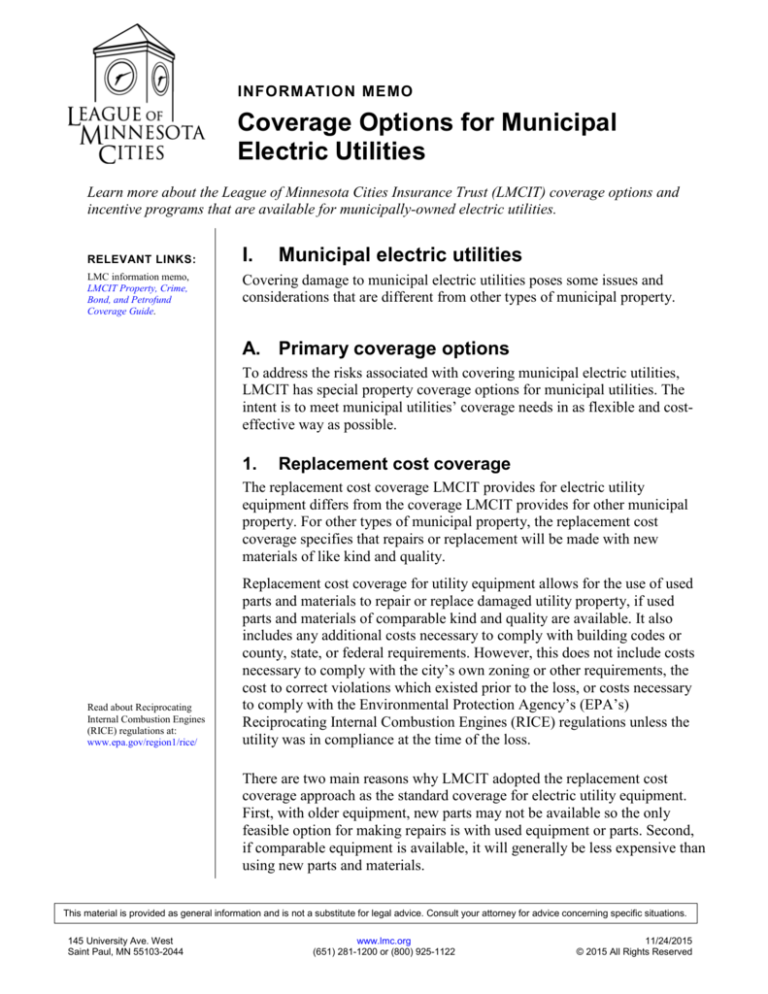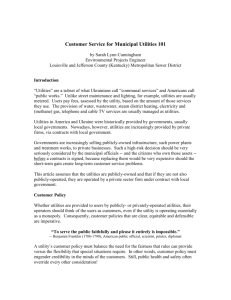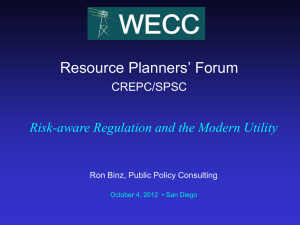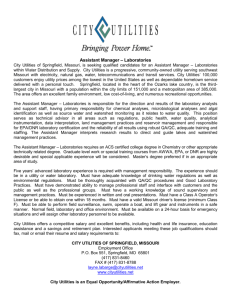
INFORMATION MEMO
Coverage Options for Municipal
Electric Utilities
Learn more about the League of Minnesota Cities Insurance Trust (LMCIT) coverage options and
incentive programs that are available for municipally-owned electric utilities.
RELEVANT LINKS:
LMC information memo,
LMCIT Property, Crime,
Bond, and Petrofund
Coverage Guide.
I.
Municipal electric utilities
Covering damage to municipal electric utilities poses some issues and
considerations that are different from other types of municipal property.
A. Primary coverage options
To address the risks associated with covering municipal electric utilities,
LMCIT has special property coverage options for municipal utilities. The
intent is to meet municipal utilities’ coverage needs in as flexible and costeffective way as possible.
1.
Replacement cost coverage
The replacement cost coverage LMCIT provides for electric utility
equipment differs from the coverage LMCIT provides for other municipal
property. For other types of municipal property, the replacement cost
coverage specifies that repairs or replacement will be made with new
materials of like kind and quality.
Read about Reciprocating
Internal Combustion Engines
(RICE) regulations at:
www.epa.gov/region1/rice/
Replacement cost coverage for utility equipment allows for the use of used
parts and materials to repair or replace damaged utility property, if used
parts and materials of comparable kind and quality are available. It also
includes any additional costs necessary to comply with building codes or
county, state, or federal requirements. However, this does not include costs
necessary to comply with the city’s own zoning or other requirements, the
cost to correct violations which existed prior to the loss, or costs necessary
to comply with the Environmental Protection Agency’s (EPA’s)
Reciprocating Internal Combustion Engines (RICE) regulations unless the
utility was in compliance at the time of the loss.
There are two main reasons why LMCIT adopted the replacement cost
coverage approach as the standard coverage for electric utility equipment.
First, with older equipment, new parts may not be available so the only
feasible option for making repairs is with used equipment or parts. Second,
if comparable equipment is available, it will generally be less expensive than
using new parts and materials.
This material is provided as general information and is not a substitute for legal advice. Consult your attorney for advice concerning specific situations.
145 University Ave. West
Saint Paul, MN 55103-2044
www.lmc.org
(651) 281-1200 or (800) 925-1122
11/24/2015
© 2015 All Rights Reserved
RELEVANT LINKS:
Estimating the replacement cost of electric utility equipment can be difficult,
in part because of the wide variety of types and ages of equipment. The goal
is to calculate a figure for what it would cost to reconstruct the facility
exactly as it was, using new materials, if the facility were completely
destroyed. This estimated replacement cost figure is then used as the basis
both for the specific coverage limit for that building, and for the premium
charge.
Although the coverage provides that used parts and equipment may be used
if available, the estimated replacement cost is always based on the cost of
making the repairs or replacement using new equipment. This is done
because it can never be assured that comparable and appropriate used
equipment will actually be available if a loss occurs. It’s always possible
that new materials would have to be used for the repair or replacement.
The estimated replacement cost for each structure is listed on the property
schedule. The specific coverage limit for that structure is 150% of the
estimated replacement cost. This is the most LMCIT would pay to repair or
replace that structure and its contents if a loss were to occur. The coverage
also includes $500,000 of coverage for loss of revenue, extra expense, and
expediting expense arising from covered damage to utility property. Higher
limits are available, but there is an additional premium charge.
LMC information memo,
LMCIT Property Appraisal
Program.
In most cases, the estimated replacement cost for each covered structure is
developed through an appraisal by LMCIT’s appraisal contractor. For
relatively new equipment (i.e. no more than a few years old) the estimated
replacement cost figure may be based on the equipment’s original cost. In
any case, it’s always important that utility staff review the estimated
replacement cost figures and make sure they appear reasonable.
If a utility has old and essentially obsolete generating equipment, an “agreed
amount” will be used for these items. In some cases (e.g. where the
equipment doesn’t play a critical role for the utility) the amount might
simply be the current market value of the property. In other situations, a
larger agreed amount may be appropriate to address the cost of replacing the
functional capacity. LMCIT underwriters will work with the utility to find a
workable solution for each situation.
LMCIT has taken the “agreed amount” approach for obsolete equipment
because new or used replacement parts may simply not be available. That
could effectively turn what might otherwise be a minor loss into a total loss.
Providing replacement cost coverage on this type of equipment is
problematic, since the risk is significantly greater than with repairable
equipment. At the same time though, that old equipment may be serving an
important need for the utility, for example by providing needed emergency
backup or peaking capacity.
League of Minnesota Cities Information Memo:
Coverage Options for Municipal Electric Utilities
11/24/2015
Page 2
RELEVANT LINKS:
2.
Agreed amount coverage
In some situations, the estimated replacement cost approach could result in
the municipal utility purchasing and paying for higher coverage limits than
what are actually needed. LMCIT offers the utility to purchase coverage for
an “agreed amount,” which is less than the estimated replacement cost of the
facility. Both the coverage limit and the premium are then based on the
lower “agreed amount.”
Following are two situations where the “agreed amount” coverage option
might make sense.
•
•
The existing facility has greater generating capacity than what the utility
actually needs. If the facility were destroyed or substantially damaged,
the utility would likely replace it with a smaller facility, possibly of a
different type. In this situation, it may make sense to use an “agreement
amount” coverage limit based on the cost of the type and size of the
replacement facility the utility would actually construct.
The existing facility uses older technology, and its capacity could be
replaced for less cost using a different technology. For example, it may
be less expensive to build a gas turbine generation facility with “x”
megawatt capacity than to rebuild a coal-fired facility. In this case, it
may make sense to use an “agreed amount” coverage limit based on the
cost of the type of the replacement facility that would actually be
constructed.
In some circumstances, this “agreed amount” approach may be an attractive
option for the utility, but it has to be done carefully. There are three key
points to keep in mind.
First, when the “agreed amount” approach is used, the coverage limit for the
facility is equal to that agreed amount, not 150% of the agreed amount. It’s
therefore important to calculate and select the agreed amount carefully and
perhaps to incorporate some safety margin in that amount as well. If the
actual cost were to turn out greater than the agreed amount that was
scheduled, the utility would have no coverage for the excess cost.
Second, in selecting an “agreement amount” for a particular facility, LMCIT
recommends the amount be based on the cost of constructing the needed
generating capacity using new materials and equipment. If the amount were
based on the estimated construction cost using used equipment, the limit
could be inadequate if it were to happen that appropriate used equipment
happened not to be available at the time of the loss.
League of Minnesota Cities Information Memo:
Coverage Options for Municipal Electric Utilities
11/24/2015
Page 3
RELEVANT LINKS:
Third, make sure the coverage limit for demolition and debris removal is
adequate, especially in situations where there’s an old facility that has
substantial unneeded and unused generating capacity. If a facility is partially
destroyed and the cost to repair that damage is equal to or greater than the
agreed amount, the utility will presumably choose to replace the facility, but
a substantial portion of the old facility might still be standing and need to be
demolished and removed.
3.
“New for old” replacement cost coverage
Utilities have the option in most cases to purchase replacement cost
coverage which entitles it to “new for old” replacement coverage, but a
higher rate is charged. In most cases, the “new for old” coverage option
probably offers little real advantage to a utility. This coverage is only
offered to utilities if it can be verified that new parts are in fact available for
the particular equipment.
B. Other optional coverages
There are some special coverage issues that municipal electric utilities face
with regard to equipment breakdown and risks associated with utility poles
and wires. LMCIT makes available additional cost coverage options for
both.
1.
Equipment breakdown coverage
LMCIT can provide equipment breakdown coverage for diesel generating
equipment, but not for other types of electrical generation equipment such as
steam or gas turbines, wind turbines, or hydro-electric facilities. LMCIT can
also provide equipment breakdown coverage for transformers and switching
equipment for utilities that don’t have generation capacity. For utilities that
have these other types of generation equipment, LMCIT will provide
assistance in placing the equipment breakdown coverage with a different
coverage provider.
When LMCIT provides equipment breakdown coverage for diesel
generation facilities, newly-acquired diesel equipment is automatically
covered for up to 90 days, subject to a $5,000,000 limit. However, the
newly-acquired equipment must be reported to LMCIT within that 90-day
period in order to have continued coverage. In general, any newly-acquired
equipment should be reported to the LMCIT underwriting department as
soon as possible, regardless of whether the equipment breakdown coverage
is being provided by LMCIT or by a private insurance company.
League of Minnesota Cities Information Memo:
Coverage Options for Municipal Electric Utilities
11/24/2015
Page 4
RELEVANT LINKS:
Two other points should be noted. First, each utility’s equipment has to be
evaluated individually. Certain equipment may not qualify for breakdown
coverage because of its age or condition. Second, at this time neither LMCIT
nor most private mechanical breakdown insurers are able to provide
coverage to electric utilities for loss of income or extra expense resulting
from an equipment breakdown loss.
2.
Utility poles and wires coverage
LMCIT’s standard property coverage excludes coverage for damage to city
utility poles and lines. This could leave some utilities with a significant
uncovered expense in the event of a widespread ice or windstorm that downs
lines. To help avoid this potential problem, LMCIT offers optional property
coverage for city utility poles and transmission and distribution lines. The
coverage is subject to a $50,000 deductible per occurrence and a $500,000
limit. The rates for the coverage are based on the number of miles of
transmission and distribution lines.
II. Incentive programs
Electric utilities can qualify for significant credits on their property coverage
rates if they have in place specified fire detection and suppression equipment
and/or if they have current documented operating procedures and preventive
maintenance schedules in place.
A. Operations and maintenance incentive program
Under the Operations & Maintenance (O&M) incentive program, electric
utilities have the opportunity to qualify for a 10% rate reduction on property
coverage if the utility has:
•
•
An up-to-date written preventive maintenance schedule including a
comprehensive inventory of critical equipment. Critical equipment
includes those pieces of equipment and/or instrumentation that if failed
would present an immediate risk or potential risk to personnel safety, of
an insurable loss, or for lost production. The utility must also have
written maintenance schedules. These may be a combination of
manufacturers’ recommendations and staff experience and expertise with
kinds of machinery used.
Documented and up-to-date operating procedures including written
procedures and guidelines for various equipment operations like startup,
shutdown, and so on.
League of Minnesota Cities Information Memo:
Coverage Options for Municipal Electric Utilities
11/24/2015
Page 5
RELEVANT LINKS:
After LMCIT determines a utility meets these criteria, the utility is then
eligible for a 10% rate reduction at their next renewal. Utilities need to
qualify for the rate reduction each year by documenting that it is keeping the
manuals and maintenance plans updated to reflect any newly-acquired
equipment, changes in the manufacturer’s recommended maintenance or
operating procedures, and so on. It is also necessary to actually conduct the
preventive maintenance in accordance with the written preventive
maintenance schedule.
There are a couple ways for utilities to meet the criteria for this incentive.
To participate in LMCIT’s
O&M project, contact Rachel
Carlson, Loss Control
Manager
651.281.1210
rcarlson@lmc.org
•
•
Utilities that participate in LMCIT’s O&M project will work with
LMCIT’s utility consultants to develop written preventive maintenance
schedules and documented operating procedures. LMCIT utility
consultants can serve about four to five utilities per year. Participation is
on a first come first serve basis, with consideration given to utility
location (utilities located near each other will save consultant travel
time) and equipment (utilities with very similar equipment will save time
and costs in document creation).
Utilities can develop and put into place its own operating manuals and
maintenance schedules. However, the documentation will be reviewed
by LMCIT utility consultants to ensure compliance prior to the credit
being applied. Any utility that has already developed and put in place
comparable operating materials and maintenance schedules will qualify
for the credit.
B. Fire protection rate credit
Utilities have the opportunity to qualify for fire protection credits in addition
to the O&M incentive credit. Credits are as follows.
Fire protection credit
Power plant
fire
detection
Diesel
plants
Power plant
fire
suppression
system
Spill
containment
Transformer
separation
2.5%
1.25%
6.25%
-
Gas turbine
plants
2%
7%
-
1%
Steam
turbine
plants (gas
or coal-fired
2%
7%
-
1%
League of Minnesota Cities Information Memo:
Coverage Options for Municipal Electric Utilities
11/24/2015
Page 6
RELEVANT LINKS:
III. Further assistance
LMCIT Underwriting
Department
651.281.1200
800.925.1122
Contact the underwriting department for additional information about
covering municipal electric utilities.
League of Minnesota Cities Information Memo:
Coverage Options for Municipal Electric Utilities
11/24/2015
Page 7






